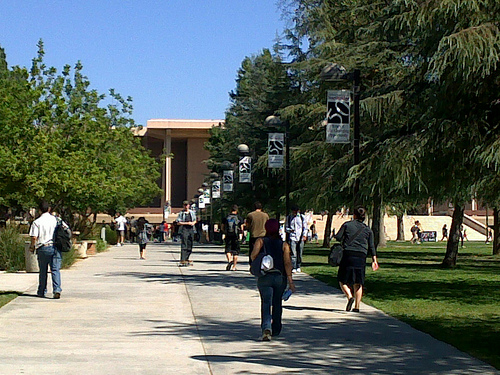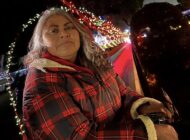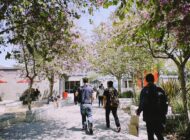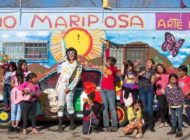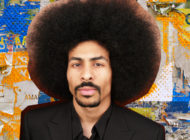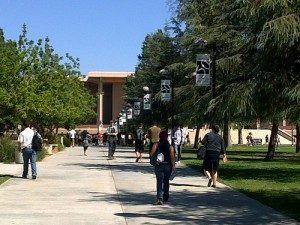
By ALLISON HATA
Students of many different backgrounds at California State University Northridge (CSUN) can be found studying in the windowsills of Manzanita Hall, walking up the steps to the Oviatt Library or grabbing a cup of coffee from The Freudian Sip. Whether they are math majors, California natives or graduating seniors, each individual is a member of the diverse student body that makes up the university.
Mariana Jalnekrian, an 18-year-old Armenian-American, set aside a book she was reading to take a quick glance around campus. From her table outside the Matador Bookstore Complex, Jalnekrian, a first-year English Literature major, contemplated the many ethnic groups at CSUN, trying to decide which was in the majority.
“Can I give two answers?” she replied after a long pause. “Hispanic and white.”
Along with several other students, Jalnekrian correctly deduced that both whites and Hispanic Americans are in a near majority at CSUN. White individuals make up slightly over a third of the student body, just barely ahead of the growing Latino and Mexican American population.
The number of students identifying themselves as white decreased by around 5 percent since 2000, while the number of Hispanic American students increased by the same amount, according to Institutional Research studies. This demographic change over the past 10 years demonstrated the narrowing gap between the two ethnic populations, which were at a nearly equal level as of the most current university statistics in 2008.
Bettina Huber, director of the Office of Institutional Research, believes that this growth in the Hispanic American population is indicative of a long-term change.
“The increase in the number of Latina/o students attending CSUN has been evident for quite a few years now,” said Huber.
The rising number of Hispanic American students, which includes Latino and Mexican Americans, has been a trend dating back several decades, according to Institutional Research (IR). U.S. Census data shows that this reflects changes in the greater demographics of Los Angeles County. While the population of LA County encompasses a much broader age range than the university, the ethnic makeup of the area provides a context to view the growing number of Latino students at CSUN.
In 2000, the Hispanic American population accounted for 44.6 percent of LA County residents, a number that has since increased by nearly 3 percent according to data from the Census Bureau’s American Community Survey.
This shift in the ethnic makeup of CSUN, particularly in the Hispanic American and white races, has been the key demographic change to take place at the university.
Sophomore microbiology major Reina Capati speculated that the ethnic population at CSUN was equally distributed. She was surprised to find out that there were clear racial majorities.
“It’s so diverse,” said Capati, 18, of the university’s student body.
Capati identified herself as being Filipino, which has consistently been one of the smallest racial groups at CSUN. The Filipino American population has remained around 4 percent, while the Asian American population as a whole has decreased from 13.1 to 12.1 percent since 2000, according to IR profiles.
Olivia Sprofera, a 20-year-old junior, believed that African Americans were the dominant ethnicity at CSUN, a conclusion she reached from her two years of living in the dorms where she said that they seemed to make up a majority of the residents. In the most recent IR reports, African Americans made up 8.3 percent of the population, a one percent increase from 2000.
The number of international students from 93 different countries has nearly doubled, bringing the current total to 6.2 percent. Students who had more than one ethnicity, belonged to an ethnicity not listed on surveys or declined to state their race made up 13.2 percent of CSUN, a number that has decreased since 2000, according to IR.
Gender has remained constant for undergraduates from 2000 to 2008, with females making up around 60 percent of the student body.
Total student enrollment by college, however, has shown varying degrees of change. Institutional Research showed that Arts, Media and Communication, Health and Human Development, and Humanities have all experienced a general increase in enrollment over the past 10 years. Science and Mathematics, and Social and Behavioral Sciences have both seen a decrease in the number of students declaring majors. Business and Economics, Education, and Engineering and Computer Science have mostly maintained a steady level of enrollment.
“In the long term, the size of various undergraduate degree programs reflects the number of students choosing to major in a discipline,” said Huber.
Colleges in which Hispanics made up a near majority of students included Engineering and Computer Science, Health and Human Development, Humanities, Science and Mathematics, and Social and Behavioral Science, according to Institutional Research. Ten years ago Hispanic Americans were part of the minority group every one of these colleges except the College of Humanities.
While Capati’s vision of an ethnically equal CSUN may not ever become a reality, the demographics are slowly changing to reflect a more diverse student population.
View California State University Northridge in a larger map
Tags: Allison Hatta CSUN demographics






